IJCRR - 9(11), June, 2017
Pages: 10-15
Date of Publication: 12-Jun-2017
Print Article
Download XML Download PDF
Water Quality Assessment of Pit-Lakes in Raniganj Coalfields Area, West Bengal, India
Author: Debnath Palit, Debalina Kar, Sharmila Roychoudhury, Aparajita Mukherjee
Category: General Sciences
Abstract:Aim: The aim of the study was to monitor the water quality of ten pitlakes which were located in Raniganj coal field area, West Bengal for three successive seasons during April 2014 to March 2015.
Methodology: In this study, physicochemical parameters of water samples were analyzed following standard methods. Statistical analyses were used to indicate the role of each parameter.
Result: Significant positive correlation was noted within hardness and chloride. The nature of the pitlakes is generally alkaline. A mean value of pH 7.65 were recorded which ranged between 6.70 and 9.10 during the study period. Significant variation found among other parameters of pitlakes. PCA reveals three most important and key influential parameters \? Hardness, Chloride and Nitrate Nitrogen content of pitlake water.
Conclusion: This observation indicates that mine waters differ in its composition with seasonal changes and having capability to change their nature with time.
Keywords: Water quality, Pitlakes, Raniganj coal field, Physico-chemical characters
Full Text:
INTRODUCTION
The opencast coal extraction method is one of the best and appropriate in the mining industries of India resulting into a void or pit which is eventually filled up by surface runoff and groundwater seepage becoming a pit-lake, the potential water reservoir (Ghosh, 2012). In India, coal is a major resource and most important primary source of energy. Coal mining activities changes drastically different sectors of our environment. The major environmental impacts on the surrounding areas and on human health are well documented by several authors’ in different times (Dhar, 1993; Ripley et al., 1996; Peplow and Edmonds, 2002; Younger, 2004; Pal et al., 2013).
Pit lakes have unique physical property than other water body. Nevertheless, pit lake waters often constitute a vast resource but of limited beneficial use (due to water quality issues); with a potential to contaminate regional surface and ground water resources (Kumar et al., 2009). Their value as resources for recreation, fisheries, water supply, and wildlife habitat depends mostly on their topography, their safety. Pit lakes may have long-term benefits as a water source for industrial activities rather than relying on natural systems. Several records were available on the assessment of the water quality of different pitlakes in India (Ghosh et al., 2005; Singh et al., 2009 and Singh et al., 2010)
Thus quality assessments of selected pit lakes in RCF has been carried out during 2014 -2015 in order to assess the present hydrological conditions, bio-profile and efficacy to evolve strategies for an ecological restoration, conservation and management.
MATERIALS AND METHODS
Study area
Raniganj Coalfield is the birth place of coal mining in the country. Area of Raniganj Coalfield is 1530 Km-2 spreading over Burdwan, Birbhum, Bankura and Purulia Districts in West Bengal and Dhanbad District in Jharkhand. Heart of Raniganj Coal Field (RCF) is, however, in Burdwan District bounded by Ajoy River in North and Damodar River in South. On the basis of geographic distribution and use pattern, 10 pitlakes were selected for studying the physico- chemical properties of their water in premonsoon, monsoon and post-monsoon, comprising the three principal seasons of a year.
Water sample analysis
Water samples were collected from 10 pitlakes in premonsoon, monsoon and post-monsoon seasons during 2014-2015 using standard protocols and guidelines. The value of each parameter was expressed as mean with standard deviations in the results.
Tests for physicochemical parameters of water samples were performed by following standard methods given by American Public Health Association (APHA, 2005) and Black (1965).
Statistical analysis
Statistical analyses were performed using the statistical package XLSTAT (Addinsoft, 2010). Graphs are drawn using Sci DAvis 1.D005 (Benkert et. al. 2014).
RESULTS
The physic-chemical variables of the ten selected mine pit lakes (PL01, PL02, PL03, PL04, PL05, PL06, PL07, PL08, PL09, PL10) water are represented as the annual mean along with standard deviations, minimum and maximum value in Table 2.
A mean value of pH 7.65 were recorded which ranged between 6.70 (Western Kajora pitlake) to 9.10 (Real Kajora) during the study period. With a mean value of 0.250 µS/cm the maximum value for conductivity was recorded in PL16 (1.024 µS/cm) and minimum was recorded in PL25 (0.062 µS/cm). The highest value of alkalinity (48 mg/L) was recorded in PL 26 (Chakrambati) with the lowest value (3mg/L) in PL 17 (Khadan kali) respectively. Total hardness value varied between 58 mg/L (Babuisol Colony) to 278 mg/L (Chakrambati) with a mean value of 156.43 mg/L. Chloride concentration ranged between 9.92 mg/L (Babuisol colony) to 69.97 mg/L (Chakrambati) with a mean value of 33.11 mg/L. Nitrate Nitrogen value varied between 0.01 mg/L to 109.20 mg/L with a mean value of 22.26 mg/L. Highest value of Phosphate phosphorous (24.58 mg/L) was recorded in Western Kajora pitlake with the lowest value (0.08 mg/L) in Babuisol colony respectively. The variation of water parameters according to seasonal mean value in different pitlakes are shown in Figure 1 to 7.
Correlation Coefficients computed among the chemical parameters of ten pit lakes showed in Table 3. Significant positive correlation was noted within hardness and chloride. Total hardness is also positively correlated with alkalinity in pit lakes. Positive correlations of chloride and alkalinity were also revealed.
Principal components analysis is a multivariate data analytic technique. It reduces a large number of variables to a small number of variables, without sacrificing too much of the information. The PCA was used to reduce water chemical parameters (variables).The contribution of the variables (%) and squared cosines of the variables of PCA analysis is represented in Table 4 and 5.
Figure 1 depicts the dendrogram plot derived from AHC analysis depending on the water quality variables. Three clusters shows the similarity above 90% among the pitlakes they include i.e. Cluster 1 and 2 contain PL 5, 6, 7, 8 and PL 2, 3, 9 having similar limno-chemical environment.
DISCUSSIONS
Variation of physicochemical parameters of ten pitlakes of Raniganj coalfield found with their mean value. Similar findings were also reported by (Palit et al., 2014; Singh, 2006). PCA reveals three most important and key influencial parameters – Hardness, Chloride and Nitrate Nitrogen content of pitlake water. Parameters are positively correlated that indicate their effect on water quality. Hierarchical clustering designates similarity and dissimilarity among pitlakes in respect to their physicochemical parameters. These may be due to the site specific complex hydrological and biological interactions which naturally occur in these ecosystems (Soni, 2007; Kido et al, 2009).
CONCLUSION
Based on the results of present studies of the pitlakes of Raniganj coalfield it can be concluded that water quality shows a prominent change in their quality. It revealed that all pitlakes changes with seasonal variation. Such changes were found in pH, Cnductivity, Alkalinity, Hardness, Chloride, Nitrate nitrogen and Phosphate phosphorous also. Major factors indicate that pitlake water quality have the potentiality to improve and restore itself with due course of time.
ACKNOWLEDGEMENT
Authors express their deep sense of gratitude to Department of Science and Technology, Government of West Bengal for financial support. Authors acknowledge the immense help received from the scholars whose articles are cited and included in references of this manuscript. The authors are also grateful to authors/ editors/ publishers of all those articles, journals and books from where the literature for this article has been reviewed and discussed.
CONFLICT OF INTEREST
As an author we do not have any conflict of interest in the present communication.
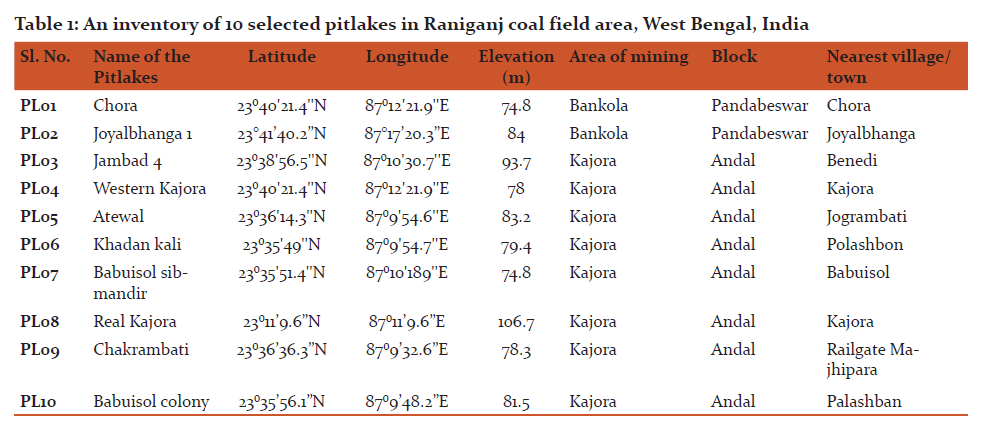

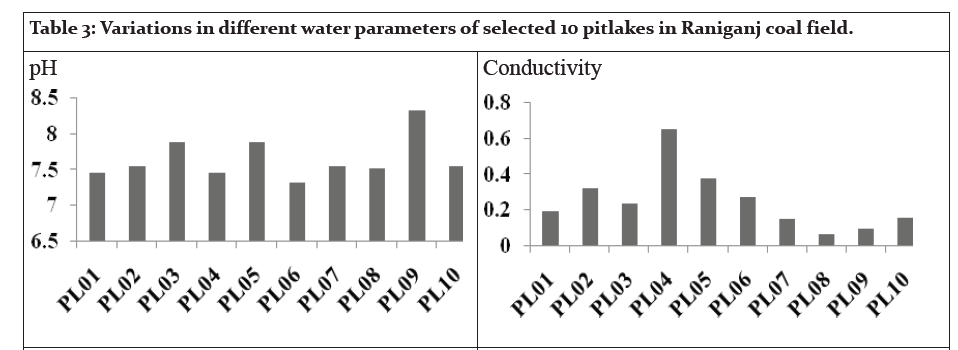


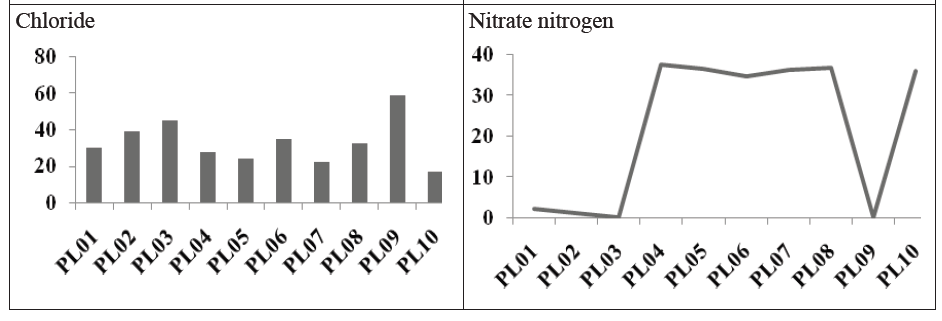
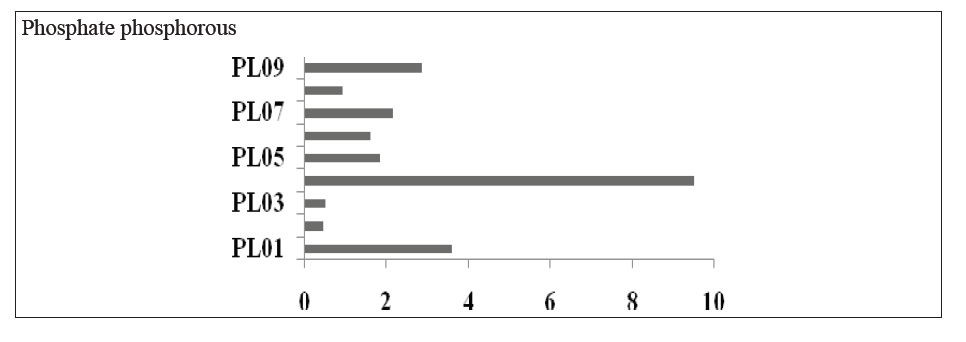



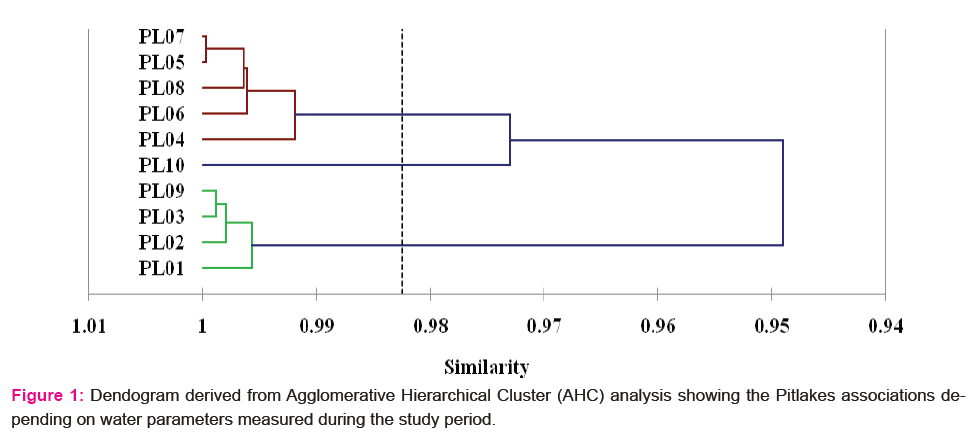
References:
- Addinsoft. XLSTAT- Statistical Analysis tool; 2010. www.xlstst.com
- APHA. Standard methods for examination of water and waste water 21 ed. American Public Health Association Washington DC. USA; 2005.
- Benkert T, Franke K, Pozitron D, Standish R. SciDAvis 1.D005 (Free Software Foundation, Inc: 51 Franklin Street, Fifth Floor, Boston, MA 02110-1301 USA); 2014.
- Black CA. Methods of Soil Analysis. Part 1 & Part 2. American Society of Agronomy Inc. Publishers, Madison, Wisconsin, U. S. A. 1965.
- Dhar BB. Environmental scenario in Indian mining industry. In: Chowdhury RN, Shivkumar SM, editors. Environmental Management, Geo-Water and Engineering Aspects. Balkema, Rotterdam; 1993. p. 615-619.
- Ghosh AR. Coal mining and climate change: an environmental vista. In: Saha GK, editor. Climate change-man and environment. New Delhi: Daya publishing house; 2012. p. 56-64.
- Ghosh AR, Pal S, Mukherjee AK. Sustainability opportunity for potential aquaculture in OCPS as a post-mining land use for rural economic development in Raniganj Coalfield areas. In: Khare D, Mishra SK, Tripathi SK, Chauhan G, Sharma N, editors. Recent advances in water resources development and management. Vol. 2. New Delhi: Allied Publishers; 2005. p. 140-155.
- Kido M, Yustiawati S, Hosokawa T, Tanaka S, Saito T, Iwakuma T, et al. Comparison of general water quality of rivers in Indonesia and Japan. Environmental monitoring and assessment 2009; 156: 317-329.
- Kumar N, McCullough CD, Lund MA. Water resources in Australian mine pit lakes. Mining Technology 2009; 118(3-4): 205-211.
- Pal S, Mukherjee AK, Senapati T, Samanta P, Mondal S, Ghosh AR. Surface water quality assessment of abandoned opencast coal pit-lakes in Raniganj coalfields area, India. The Ecoscan 2013; Special issue, Vol. IV: 175-188.
- Palit D, Kar D, Mukherjee A, Gupta S. Pitlakes of Raniganj Coal Field, WB, India. Inventory and Water Quality Status 2014; 9(1): 1-6.
- Peplow D, Edmonds R. The effect of mine waste contamination on fish and wildlife habitat at multiple levels of biological organization, Mathow River, Washington. Project No. 1998- 03501 (BPA report DOE/BP-00004710-2). 2002.
- Ripley EA, Redmann RE, Crowder AA. Environmental effects of mining. St. Lucie Press, Delray Beach. 1996.
- Singh AK, Mahato MK, Neogi B, Singh KK. Quality Assessment of Mine Water in the Raniganj Coalfield Area, India. Mine Water Environment 2010; 29: 248–262.
- Singh AK, Mondal GC, Tewary BK, Sinha A. Major ion chemistry, solute acquisition processes and quality assessment of mine water in Damodar Valley Coalfields, India. Abstracts of the international mine water conference 19th – 23rd October 2009, Proceedings ISBN Number: 978-0-9802623-5-3. Document Transformation Technologies, Pretoria. 2009; 267-276.
- Singh G. Impact of coal mining on mine water quality. International journal of mine water 2006; 7(3): 49-59.
- Soni AK. Evaluation of hydrogeological parameters associated with lime stone mining: a case study from Chandrapur, India. Mine water environment 2007; 26: 110-118.
- Younger PL. Environmental impacts of coal mining and associated wastes: A geochemical perspective. Geological Society, London 2004; 236: 169-209.
|






 This work is licensed under a Creative Commons Attribution-NonCommercial 4.0 International License
This work is licensed under a Creative Commons Attribution-NonCommercial 4.0 International License